March 2021
Welcome
Welcome to the March issue of the USAPEEC ASEAN Regional Newsletter.
This newsletter seeks to provide readers with useful product and major market information for institutional and consumer users of U.S. poultry. Readers will find a variety of general market information, activities as well as useful product information in every issue.
This month's issue:
Contents
-
Market News
- Singapore’s Booming Halal Dining Market
- 30x30 Express Grant to Ramp Up Local Food Production
-
Food Service
- Those Amazable Meatballs!
- Reinventing Your Easter Leftovers
-
Industry Trends
- From Farm to Fork: Technology Accelerates Food Safety
- Drive-In Dining Takes Customers for A Spin
-
In The Region
- ASEAN News in Brief
Additional Market Information Available
We have updated our website to include more information on market reports and export documentation guidelines.
You can visit our ASEAN website at: www.usapeecasean.com
|
Singapore’s Booming Halal Dining Market

Singapore’s Halal dining scene is booming
(Photo: Superfood Asia)
With the global burgeoning Halal industry, Halal products have expanded beyond Muslim economies, where they have become the new benchmark for safe and hygienic food. Countries like Malaysia, Korea, Japan, Brunei, China and Indonesia have been at the forefront of tapping into the global Halal market. As for Singapore, the government’s stringent and internationally recognized food safety and Halal standards give the country an enviable edge to go big.
On the local front, Singapore’s Halal dining scene is growing from strength to strength as more food and beverage (F&B) outlets open. A report on Muslim consumer behavior and Halal food trends estimated the Halal dining market to be worth SGD 1 billion in 2019, with SGD 700 million spent by local Muslims.
Muslim lifestyle and travel consultancy, CrescentRating and global payment technology solutions company Mastercard, released the 58-page report on March 3. CrescentRating focused this study on the local F&B industry as most destinations are likely to concentrate on domestic markets this year, due to the pandemic.
The data was based on input from 500 Muslims, aged 15 to 70, responding to a survey questionnaire, as well as interviews with experts and academics on Halal food. The report also includes findings from studies on Halal food in Singapore, and insights from Halal Trip (CrescentRating’s online travel platform). Almost 78% of the respondents were female.
While 65% of the respondents agree that there is a wide variety of Halal food in Singapore, some feel that Halal options are not readily available in the western and heartland areas. Most are concentrated in clusters along Arab Street and Geylang Serai. About 4 in 10 respondents would like more non-Asian cuisines like French, Mexican, Greek and Spanish offered as Halal fare. About 88% of the respondents said they learn about new Halal food options through social media while diners, aged 25 to 34, tend to share their experiences and opinions on WhatsApp, Facebook and Instagram.
Despite the rise of home-based businesses during the pandemic, less than 5% of the respondents said they buy from them on a weekly basis. Another 27% buy once or twice a month, while almost a quarter have never bought from home-based businesses. Among the concerns listed are inconvenient collection methods, high prices and delivery fees, perceived poor quality and Halal assurance.
|
|
30x30 Express Grant to Ramp Up Local Food Production
Singapore is heavily reliant on the world for its food needs, with more than 90% of food currently imported. This makes the country highly vulnerable to fluctuations in global food supply and prices. To safeguard against supply chain disruptions, the government launched its “30 by 30” vision in 2019 for Singapore to produce 30% of its nutritional needs by 2030. Even before the COVID-19 crisis hit, the climate crisis posed a threat to the global food supply, negatively impacting crop yields. However, the demand for food is expected to continue to rise as the affluence of developing countries grows. In times of crises, having a robust local food supply to fall back on, ensures that Singapore has ample food supply stocks to cater to the demands of its population, as was the case with the sudden emergence of the pandemic last year.
In April 2020, the Singapore Food Authority (SFA) moved to ramp up local production. The agency issued an open grant of SGD 30 million under the 30x30 Express Grant scheme. The grant directed local agri-food players and local farms to submit proposals to accelerate the production of eggs, fish and leafy vegetables.
SFA has since increased its budget to SGD 40 million to support successful proposals from nine high-tech farms to increase production capacity, from 6 to 24 months. Among the recipients are vegetable farms ComCrop, Green Harvest, I.F.F.I, LivFresh, Genesis One Tech Farm and VertiVegies, and one egg farm, Chew's Agriculture. The funds will go towards projects such as building additional greenhouses, leveraging technology and automation to reduce manpower, and bringing artificial intelligence to high-tech farms. For example, I.F.F.I will build a mega high-tech indoor vegetable farm using AI to monitor the growth of its leafy greens, along with an advanced environmental control system to ensure optimum yield all year round. The farm will also use an innovative water treatment system to reduce bacteria in the crops and extend the shelf life of its produce.
Many ASEAN countries are relooking their strategy to promote domestic supply in light of evolving global trends. Singapore has a sound policy of building resilience in its food supply and is future ready to meet the growing food demands of its population, improve the efficiency of local food production and delivery, and maximize the benefits of international trade.
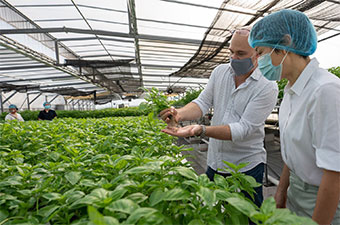
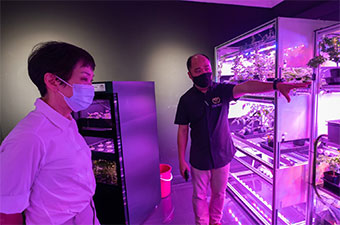
Minister for Sustainability and the Environment, Grace Fu checks in to two high-tech farms (Photo: Grace Fu’s FB)
|
Those Amazable Meatballs!
When we think of meatballs, Italian meatballs and spaghetti come to mind. This dish, however, did not originate in Italy. But Italians can take credit for the original Polpettine (meatballs), made with stale bread and ground meat like turkey and fish. Italian meatballs are traditionally served on their own or with soups, not with spaghetti. The American version emerged from impoverished Italian immigrants, circa early 1900s. As they worked their way up and could afford to buy more meat, their favorite home-style comfort food of meatball size grew too. The addition of spaghetti is also rooted in how easy it was to get spaghetti at the time, the only pasta available to Italians then. And that’s how the Italian-American meatballs with spaghetti came about!
Elsewhere across the world, you can find different variations of these round balls of tender juicy meat. In Persian cuisine, meatballs have been a staple, and here is where the technique of “gilding” (coating or glazing the meatballs) originated. Known as Kofta, they are consumed across the Middle East, with vegetarian versions particularly common in India. The French have their Boulettes and the Spanish have their Albondigas, both of which refer to meatballs in soup. Swedish meatballs call for tender meatballs, hand made from scratch and served with a rich, creamy sauce. China is famed for its Lion’s Head. Traditionally, this casserole dish features oversized pork meatballs and greens, made with pork fat and cooked in a sand clay pot. And who can resist the Vietnamese Pho Bo Vien, a noodle soup with meatballs?
Immersed in a healthy portion of gravy, or served in bubbling hot soup, there are countless ways to prepare meatballs. Previously meatballs were meant for only one thing: the plump, beefy Italian-American variety, served with spaghetti and a dose of thick tomato sauce. Times have changed. Meatballs now come in a range of shapes and sizes, ingredients, applications, and cooking styles. Meatballs are easy to love and simple to make, and you can find loads of recipes online.
Healthy or not?
When you think about healthy snacks, meatballs probably will not top the list. Delicious as they are, meatballs are high in carbohydrates, that make them less appealing to diet-conscious eaters. Traditionally, meatballs are made with ground beef or pork, egg, cheese or milk, breadcrumbs, spices, and other additives like sugar and binding ingredients.
Packaged varieties may be high in sodium. According to the USDA, three Italian-style frozen meatballs contain 160 calories, 12 grams of fat, 8 grams of protein and 4 grams of carbohydrates. Adding sauce, pasta and cheese will only increase your calorie intake!
If you want to enjoy traditional meals minus the high carbs, reduce the portions. Or get creative in the kitchen. There are many ways to make your meatballs healthier without sacrificing flavor. One is to use chicken or turkey instead of beef or pork, to lower the consumption of saturated fats. You can also try meatball recipes that use less bread to cut down on carbohydrates. Rule of thumb: if you go heavy on the meatballs, go light on the spaghetti.
-edited.jpg)
Italian meatballs are eaten on their own
(Photo: Fidel Fernando)
-edited.jpg)
Spaghetti and Meatballs
(Photo: MadMax Chef)
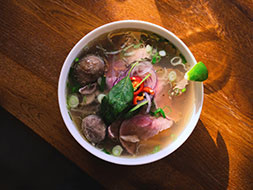
A hearty bowl of Pho Bo Vien - Vietnamese Meatball Soup
(Photo: Marek Minor)
|
|
Reinventing Your Easter Leftovers
Easter is a universal celebration for Christians to mark the resurrection of Christ. Easter falls on the first Sunday after the Full Moon date, based on mathematical calculations, that falls on or after March 21. If the Full Moon is on a Sunday, Easter is celebrated on the following Sunday.
There are a few things like Easter eggs, bunnies and chocolates that are common in Easter celebrations. All over the world, the customs are more or less alike: carnivals, egg-exchange, eating, and egg hunts.
In ancient times, staining of chicken eggs in red was the tradition. Modern customs have switched to decorating eggs with chocolate or sharing plastic eggs filled with candy. These eggs are also used in in games like the egg-hunt or egg rolling on Easter mornings.
Egg Cake Pops: You can make your Easter sweeter with these delightful cake-pops. Form the moist bites into egg shapes and skewer through sticks to make lollipops. Take it a step further and decorate the cake pops with frosting, fondant, patterns and sprinkles for that festive flavor.
Easter Bunny Pancakes: Mix flour, eggs and milk in a bowl and whip well. Once the batter is ready, form 3 small oval-shaped pancakes to make bunny arms and feet, and two larger ones for the head and body. Dip the paws into melted chocolate and top off with maple syrup.
Easter Bread: An Italian and Greek traditional dish, this light and airy bread is a great addition to any Easter platter. The yeast dough is paired with large eggs and a little almond extract to make the bread a little sweeter. Use up any leftovers to make a delicious French toast the next morning.

Kids go wild with Egg Cake Pops!
(Photo: The Spruce Eats)

The Easter Bunny – good enough to eat!
(Photo: Delish)

Go Greek and add bread to your Easter platter!
(Photo: The Food Network)
|
Farm to Fork: Technology Accelerates Food Safety
Contaminated food causes an estimate of 600 million people to fall ill and 420 thousand deaths annually (WHO Report 2020). As consumer concerns over novel viruses and diseases increase, food producers face immense pressure to come clean about the steps they are taking to align with health and food safety guidelines, to prevent the spread of foodborne diseases. A Zebra Technologies’ Food Safety Supply Chain Vision Study showed that seven in ten consumers want to know about the origins of their food, manufacturing process, ingredients being used, food preparation and handling along the entire supply chain.
Trade disruptions and consumer stockpiling in the early phases of the pandemic have forced many food companies to recognize the importance of food safety, quality, storage and delivery if they are to survive in the long-term.
Technology is often seen as a solution to tackle the efficient optimization of the food supply chain and reduce the risk of foodborne illnesses through proper tracking, handing and storage. For instance, labor issues, traceability and food safety concerns are already pushing Asia’s egg industry towards automation and robotics, to enhance safety in a post-pandemic world. Packing and grading operations enable producers to establish customers’ safety and quality assurance protocols.
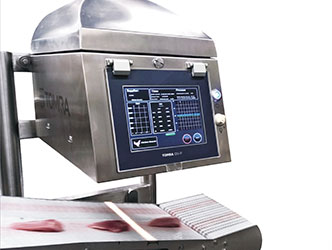
The TOMRA QV-P allows for accurate grading of chicken fillets
(Photo: TOMRA)
Preparation & Handling
With the help of Artificial Intelligence, TOMRA Food is preventing the risk of contamination and foodborne illnesses. The company recently introduced the TOMRA QV-P, an in-line detector that identifies the muscle myopathy in single chicken fillets or chicken butterfly pieces, that cause a condition known as chicken wooden breast, which makes the meat hard and chewy. Prior to this, food manufacturers had to check each piece of fillet before processing using the ‘thumb check’. The TOMRA QV-P dedicated software allows for the accurate grading of chicken fillets against a specific criterion automatically and quickly.
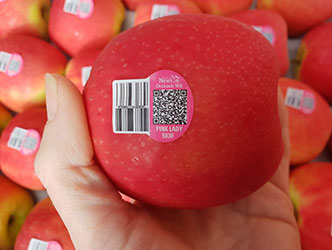
DiMuto assigns produce with a unique digital identity with QR codes
(Photo: DiMuto)
End-to-End Remote Traceability
Trade technology service, DiMuto provides end-to-end flow and supply chain visibility for global businesses during the various transaction stages of goods. DiMuto’s Digital Asset Creation (DAC) system assigns a customer’s physical products with a unique digital identity utilizing QR codes that can be uploaded and accessed through mobile applications. Each QR code is keyed with product and trade information, photos, origins and points of aggregation in the supply chain, enabling manufacturers to track and input feedback on the produce or product. The agrifood start-up has tagged and traced over 30 million fruits and over USD 100 million worth of agrifood trades in multiple countries including the U.S., Malaysia, Indonesia, Thailand and China.
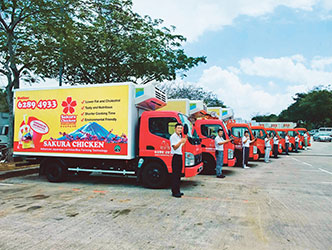
Kee Song's freezer-equipped trucks maintain optimal freshness for their food products
(Photo: DBS bank)
Cold Chain Management
Growth of international trade during the pandemic and increasing demand for fresh and frozen products have put the onus on cold chain management as a crucial factor to ensure food safety, across the storage, transportation and distribution processes. As one of Singapore’s major poultry suppliers, Kee Song Food Corporation, which supplies to supermarkets, wet markets, food manufacturers and online retailers, has invested in twenty freezer-equipped delivery trucks. This is in addition to a fleet of chiller-equipped delivery trucks to maintain optimal freshness for their products.
Consumers today are clear about what they expect from supermarkets, shops and restaurants, and this includes the precise ingredients of food sold, where and how they are sourced to support the claims on the labels. From an industry perspective, this means consumers are relying on the point of retail to make sure that food is safe, forcing retailers and brands to bear the responsibility for food safety – from farm to fork.
|
|
Drive-In Dining Takes Customers For A Spin
As most countries continue to deal with lockdowns and movement restrictions, drive-in dining is gaining traction in Asia. Food and beverage businesses were hit the hardest as sales fell by 80% due to the pandemic as customers resorted to dining-in, in the comfort of their homes. Not an industry to rest on its laurels, restaurants are looking to novel ways to entice customers.
Padi House at Cyberjaya in Malaysia, which has 10 outlets, uses its parking lot to cater to customers. The concept for this service combines the idea of airline meals and the trend of car-hop dining from back in the day when servers brought the order directly to cars. Prices are kept as low as RM 10 (USD 2.50) and all set meals come with a drink and dessert. Favorites include Beef Yakiniku and Chicken Katsu Bento served with Calrose rice, salad, edamame, tamagoyaki and potato salad priced at RM 20 (USD 4.90), as well as the Scallion Fried Rice with Fried Chicken priced at RM 15 (USD 3.70). Padi House also offers dessert options, like the signature Macadamia Cheesecake, which comes with a free cup of coffee.
In the Philippines, Bamba Bistro launched their drive-in dining service in August last year. They offer drive-in kits that come with special trays, utensils, plates and cups - for passengers to enjoy their meals comfortably in the backseat. Bamba Bistro tops the services off with a Spotify playlist for that full Bamba experience.
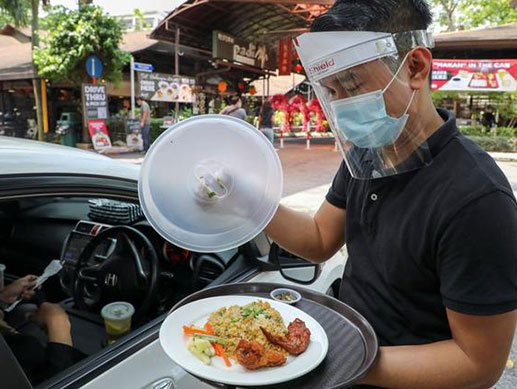
Dine in the safety of your own car at Padi House’s parking lot
(Photo: Reuters)
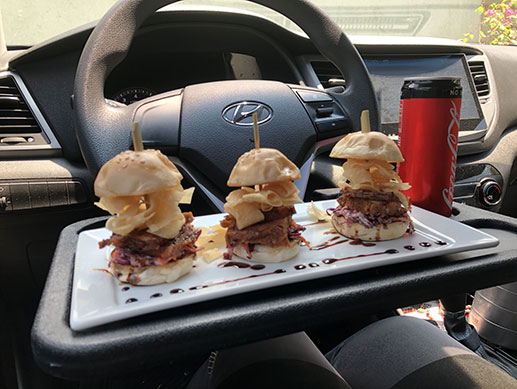
Bamba Bistro offers a Spotify playlist for that full drive-in dining experience
(Photo: Tatler Philippines)
|
![]() Cambodia
Cambodia
Burgershack opens in Phnom Penh
Burgershack announced the launch of a new outlet in Phnom Penh with a vibrant interior filled with graffiti-style murals. The outlet serves traditional California-style burgers, including vegetarian and vegan options made with a blend of Shitake mushrooms and pea protein. First opened in 2018, in Kampot, the burger joint is known for its Double Bacon Cheeseburger, Spicy Jalapeno Burger and Clucking Good Chicken Burger.
![]() Indonesia
Indonesia
Prime market for Halal foods
With the largest Muslim population of 231 million (globally), analyst firm, Food Navigator says there is an internationalization opportunity for foreign brands to tap into the Indonesian Halal foods market, expected to grow by 2.2% and hit USD 19.2 billion by 2024. Indonesia is seeing a rise in middle income consumers with higher purchasing power and consumer openness to international food trends such as Korean, Japanese and European foods that are Halal-certified.
Expansion of cloud kitchen network
Southeast Asia’s ride-hailing company, Grab, is partnering with Indonesia’s cloud kitchen startup, Yummy Corp, to strengthen its food business in Indonesia. The partnership expands their combined networks to more than 80 cloud kitchens in seven cities, giving culinary entrepreneurs access to facilities to launch virtual restaurants and expand their reach. Yummy Corp will assist brands to set up stores, and handle branding and staff training, while Grab will assist with delivery and data analytics. Merchants registered with Yummy will be integrated into Grab’s ecosystem, where there are currently more than 200 brands.
![]() Singapore
Singapore
McDonald's brings back McGriddles
McDonald's Singapore is bringing the maple syrup-drenched breakfast treat, McGriddle back for a limited time in March. You can choose from a menu of Sausage McGriddles (SGD 4.50), Sausage McGriddles with Egg (SGD 5.40), McGriddles Stack (SGD 6.20) which comes with a piece of crisp chicken bacon, and the McGriddles Feast including a chocolate pie and exclusive McGriddles stickers (SGD 7.50).
Pepper Lunch is officially Halal-certified
As of February 8, all Pepper Lunch outlets became Halal-certified. The brand had worked for over a year to get the certification through product evaluations, documents traceabilities, Halal compliance reviews and mock audits. Pepper Lunch is famous for its Beef Steaks, Salmon Pepper Rice, Teriyaki Chicken, Miso and other dishes. There are 8 Pepper Lunch restaurants and 17 Pepper Lunch Express outlets within food courts in Singapore.
New SGD 60 million fund to boost food production
A new Agri-Food Cluster Transformation Fund will replace the existing Agriculture Productivity Fund. Under the new funding, the government will set aside SGD 60 million to harness technology against climate change constraints that could disrupt global supply chains and threaten global food production.
AirAsia Food launches in Singapore
Malaysian budget carrier AirAsia has launched its food delivery service in Singapore, its first overseas foray. The food platform currently carries about 80 restaurants, including Swee Choon Tim Sum Restaurant and No Signboard Seafood, and is in the process of bringing 300 other restaurants onboard. The company has recruited 500 delivery riders and aims to double the number by the third quarter of this year.
![]() Thailand
Thailand
New Ba Hao Tian Mi to offer savory bites
Chinatown sweet shop, Ba Hao Tian Mi, has entered Thonglor with a bigger space and an expanded menu offering a variety of flavorful international dishes from Hong Kong, Singapore, and Taiwan. Some of the best-sellers include Spicy Chili Crab with Deep-Fried Pumpkin Mantoux, the BHTM Brunch Set (a Chinese-style brunch featuring scrambled eggs, fried pork cubes, Chinese sausage, salad, and bread with homemade butter) and Taiwanese-inspired Coffin Bread Mushroom Chowder. The eatery also offers its signature pudding with exclusive flavors that rotate monthly.
![]() Vietnam
Vietnam
Retail sales surge ahead of Lunar New Year
Retail sales in Vietnam surged 6.4% in January, ahead of the Lunar New Year (the country’s biggest holiday of the year). Generating close to USD 20.7 billion for the month, the sales were significantly higher with consumer goods accounting for 79% of the revenue. The food service and accommodation industry rose by 2.7% compared to December 2020. The new year holidays and numerous promotional programs stimulated retail consumption, as supermarkets and shopping centers recorded high traffic and sales.
|
|
Disclaimer: All opinions and views expressed in the articles published in the newsletter are those of the individual journalists and do not necessarily reflect those of the publisher, the newsletter's sponsors or USA Poultry & Egg Export Council.
You are receiving this email because you registered to get newsletters from USAPEEC ASEAN.
If you prefer not to receive these updates, please click here to unsubscribe.
Do not reply to this email. For enquiries, go to www.usapeecasean.com
® USA POULTRY & EGG EXPORT COUNCIL
541 Orchard Road, #15-04, Liat Towers, Singapore 238881 Tel: (65) 67371726 Fax: (65) 67371727
Representative Office registered in Singapore